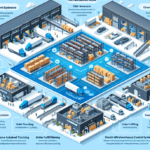Introduction to Warehouse Management Systems (WMS)
Warehouse Management Systems (WMS) have transformed warehouse operations globally, especially with the surge in e-commerce. A WMS is essential for managing inventory, tracking shipments, processing orders, and overseeing warehouse staff. Modern WMS solutions offer real-time inventory updates, location tracking, and robust data analytics, which enhance operational efficiency and minimize manual errors.
Automation is a significant advantage of WMS, streamlining processes such as inventory movement, order picking and packing, and employee scheduling. Additionally, seamless integration with other systems like Transportation Management Systems (TMS) and Enterprise Resource Planning (ERP) provides a comprehensive view of the supply chain, further optimizing operations.
Feature Comparison: Blue Yonder WMS vs Oracle Warehouse Management Cloud
Real-Time Inventory Tracking and Management
Both Blue Yonder WMS and Oracle Warehouse Management Cloud (WMS) offer robust real-time inventory tracking. This feature ensures accurate inventory levels, reduces stockouts, and enhances overall inventory management.
Order Processing Automation
Automation of order processing is a key feature in both systems. Blue Yonder WMS excels with its automated replenishment and customizable dashboards, while Oracle WMS offers automated wave processing, enabling efficient handling of large order volumes.
Task Management and Optimization
Task management capabilities are advanced in both solutions. Blue Yonder focuses on optimizing labor through task management, whereas Oracle provides highly configurable task workflows tailored to complex supply chain needs.
Integration Capabilities
Integration is seamless with other enterprise systems. Blue Yonder WMS integrates well with various ERP and TMS solutions, offering flexibility. Oracle WMS, on the other hand, integrates effortlessly with other Oracle Cloud services, providing a unified platform for users already within the Oracle ecosystem.
Pricing Comparison
Blue Yonder WMS offers tiered pricing starting at approximately $25,000 annually for basic plans, scaling up to $100,000 or more for enterprises requiring extensive features and support. In contrast, Oracle Warehouse Management Cloud does not publicly disclose pricing, necessitating direct contact with Oracle for tailored quotes. Businesses are encouraged to assess their specific needs and budget constraints when evaluating these solutions.
Implementation Process
Implementing a WMS can be complex and time-consuming. Blue Yonder WMS typically requires a few months for full implementation, supported by a team of experts to ensure a smooth transition. Oracle WMS implementations may take longer and often require additional IT support due to its advanced customization capabilities. Proper planning and collaboration with the vendor are crucial for a successful deployment.
Customer Support Services
Customer support is a critical factor in WMS selection. Blue Yonder provides comprehensive support, including phone, email, and chat options, along with a rich knowledge base of articles and tutorials. Oracle WMS offers dedicated customer success managers and various support channels, though the responsiveness may vary based on the subscription level. Evaluating the quality and accessibility of support services is essential for ongoing system efficiency.
User Experience and Interface
User experience can significantly impact the effectiveness of a WMS. Blue Yonder WMS is renowned for its user-friendly interface and customizable dashboards, making it easier for users to access real-time data. It also offers a mobile application for on-the-go access. Oracle WMS provides a highly customizable interface but may present a steeper learning curve, potentially requiring more training for users to navigate effectively.
Integration Capabilities
Effective integration with existing systems enhances the functionality of a WMS. Blue Yonder WMS supports integration with various ERP and TMS systems, allowing for customizable workflows and data fields. Oracle WMS excels in integrating with other Oracle Cloud products, providing a seamless experience for organizations already utilizing Oracle’s suite of tools. Assessing compatibility with current systems is vital to ensure a cohesive operational environment.
Case Studies
Companies Using Blue Yonder WMS
- Walmart
- Amazon
- Coca-Cola
- PepsiCo
Companies Using Oracle Warehouse Management Cloud (WMS)
- Red Bull
- Daifuku
- Hilti Corporation
- Toyota
Conclusion: Choosing Between Blue Yonder WMS and Oracle Warehouse Management Cloud
Deciding between Blue Yonder WMS and Oracle Warehouse Management Cloud (WMS) depends largely on specific business requirements. Blue Yonder offers a wide array of features with a user-friendly interface, making it suitable for businesses seeking ease of use and comprehensive support. However, it comes at a higher cost. On the other hand, Oracle WMS provides extensive customization and integrates seamlessly with other Oracle products, ideal for larger enterprises with complex supply chain needs. Both systems offer real-time inventory tracking, task management, and robust integration capabilities. Businesses should conduct a thorough needs assessment and consider factors such as budget, existing systems, and scalability when selecting the appropriate WMS solution.




















